This article needs additional citations for verification .(November 2007) |

Military tradition is the practices associated with the military or soldiers such as the styles of military uniform, drill, or the music of a military unit.
This article needs additional citations for verification .(November 2007) |

Military tradition is the practices associated with the military or soldiers such as the styles of military uniform, drill, or the music of a military unit.
In the United States, military tradition can refer simply to a father-son relationship or a much longer, ancestors-long line (which is the normal meaning).[ clarification needed ] Military tradition refers to the tradition in a family to systematically destine one of its sons for a military career. This tradition is associated to the Southern United States who, as a whole, would have a military tradition. This is represented in the much higher representation of Southerners in the U.S. Military today and throughout the nation's history. [1] [2]
In Europe, tradition was a principle of military culture that had evolved out of the Middle Ages' concept of chivalry.
Within Europe a wide variety of separate military traditions developed until at least World War I. Subsequently, major political and social changes have tended to break-down the historical continuity that had been a source of military tradition in many armies.
In Britain, military traditions developed primarily along regimental lines, taking the form of long-established regimental customs, insignia, badges and distinctive features of uniform. Since the late 1960s, a series of regimental mergers and disbandments have diluted British military tradition, although it still remains strong in the Guards Division.

In Prussia and the German Empire, states relied on their own history to maintain military traditions, although some specific regiments within elite formations did maintain distinctive customs and items of dress. For example, one regiment, the Potsdam Grenadiers, consisted of extremely tall men.
The French created the concept of Esprit de Corps , or pride in ones unit, within most elite or uniquely French units. North African units like the Zouaves, the Turcos, the French Foreign Legion, or even the Mamelukes which served in Napoleon Bonaparte's Imperial Guard developed distinctive styles of dress. Many of these distinctive styles were later adopted by the French Metropolitan Army during the nineteenth century.
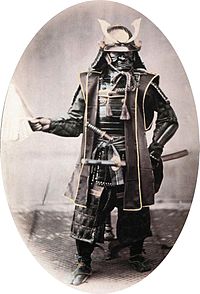
In Japan, most military tradition was based on the bushido code. Bushido, translated as 'way of the warrior' in English, was the strict code of military discipline adhered to by Samurai warriors.
Military Tradition is used in the strategy game Sid Meier's Civilization III , released by Atari, as a technological advance that allows the building of cavalry units.
Military Tradition is a game concept in the strategy game Europa Universalis IV released by Swedish PC strategy game designer, Paradox Interactive. In the game, a player-controlled faction can accumulate Military Tradition by engaging in land battle. A higher Military Tradition value results in the ability to recruit generals and conquistadors of better quality.
Distinct elements of a military culture are also present in many fictional publications. These are often used as an important element in shaping fictional culture by authors. Military fiction is a key component of the "military and popular culture" subfield. [3]

The French Foreign Legion is an elite corps of the French Army that consists of several specialties: infantry, cavalry, engineers, airborne troops. It was created in 1831 to allow foreign nationals into the French Army. It formed part of the Armée d’Afrique, the French Army's units associated with France's colonial project in Northern Africa, until the end of the Algerian War in 1962.
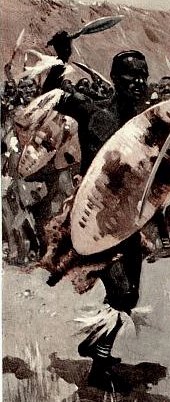
Impi is a Nguni word meaning war or combat and by association any body of men gathered for war, for example impi ya masosha is a term denoting an army. Impi were formed from regiments from large militarised homesteads. In English impi is often used to refer to a Zulu regiment, which is called an ibutho in Zulu or the army.

In military organizations, a colour guard is a detachment of soldiers assigned to the protection of regimental colours and the national flag. This duty is highly prestigious, and the military colour is generally carried by a young officer (ensign), while experienced non-commissioned officers are assigned to the protection of the national flag. These non-commissioned officers, accompanied in several countries by warrant officers, can be ceremonially armed with either sabres or rifles to protect the colour. Colour guards are generally dismounted, but there are also mounted colour guard formations as well.

A grenadier was historically an assault-specialist soldier who threw hand grenades in siege operation battles. The distinct combat function of the grenadier was established in the mid-17th century, when grenadiers were recruited from among the strongest and largest soldiers. By the 18th century, the grenadier dedicated to throwing hand grenades had become a less necessary specialist, yet in battle, the grenadiers were the physically robust soldiers who led vanguard assaults, such as storming fortifications in the course of siege warfare.
Military science is the study of military processes, institutions, and behavior, along with the study of warfare, and the theory and application of organized coercive force. It is mainly focused on theory, method, and practice of producing military capability in a manner consistent with national defense policy. Military science serves to identify the strategic, political, economic, psychological, social, operational, technological, and tactical elements necessary to sustain relative advantage of military force; and to increase the likelihood and favorable outcomes of victory in peace or during a war. Military scientists include theorists, researchers, experimental scientists, applied scientists, designers, engineers, test technicians, and other military personnel.

The Canadian Army is the command responsible for the operational readiness of the conventional ground forces of the Canadian Armed Forces. It maintains regular forces units at bases across Canada, and is also responsible for the Army Reserve, the largest component of the Primary Reserve. The Army is headed by the Commander of the Canadian Army and Chief of the Army Staff, who is subordinate to the Chief of the Defence Staff. The Army is also supported by 3,000 civilian employees from the public service.
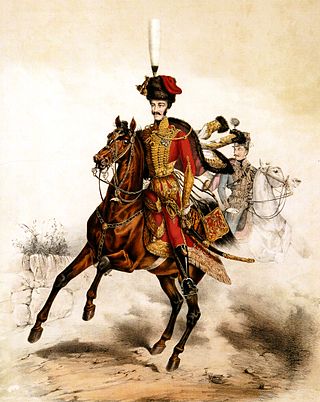
A hussar was a member of a class of light cavalry, originating in Central Europe (Hungary) during the 15th and 16th centuries. The title and distinctive dress of these horsemen were subsequently widely adopted by light cavalry regiments in European armies during the late 17th and 18th centuries. By the 19th century, hussars were wearing jackets decorated with braid plus shako or busby hats and had developed a romanticized image of being dashing and adventurous.

Epaulette is a type of ornamental shoulder piece or decoration used as insignia of rank by armed forces and other organizations. Flexible metal epaulettes are referred to as shoulder scales.

A slouch hat is a wide-brimmed felt or cloth hat most commonly worn as part of a military uniform, often, although not always, with a chinstrap. It has been worn by military personnel from many different nations including Australia, Ireland, the United Kingdom, Canada, India, New Zealand, Southern Rhodesia, France, the United States, the Confederate States, Germany and many others. Australia and New Zealand have had various models of slouch hat as standard issue headwear since the late Victorian period.
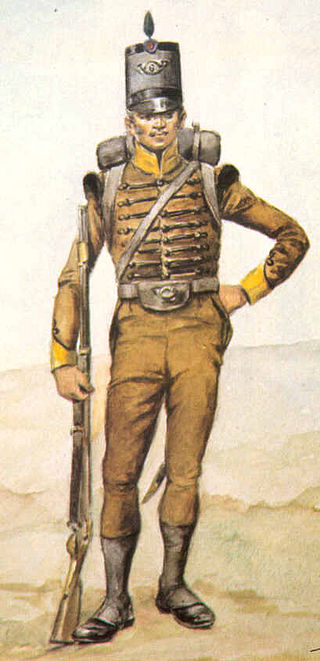
Light infantry refers to certain types of lightly-equipped infantry throughout history. They have a more mobile or fluid function than other types of infantry, such as heavy infantry or line infantry. Historically, light infantry often fought as scouts, raiders, and skirmishers. These are loose formations that fight ahead of the main army to harass, delay, disrupt supply lines, engage the enemy's own skirmishing forces, and generally "soften up" an enemy before the main battle. Light infantrymen were also often responsible for screening the main body of a military formation.

A military uniform is a standardised dress worn by members of the armed forces and paramilitaries of various nations.

For centuries, Spain recruited foreign soldiers to its army, forming the foreign regiments such as the Regiment of Hibernia. However, the specific unit of the Spanish Army and Spain's Rapid Reaction Force, now known as the Spanish Legion, and informally known as the Tercio or the Tercios, is a 20th-century creation. It was raised in the 1920s to serve as part of Spain's Army of Africa. The unit, which was established in January 1920 as the Spanish equivalent of the French Foreign Legion, was initially known as the Tercio de Extranjeros, the name under which it began fighting in the Rif War of 1921–1926.

The pith helmet, also known as the safari helmet, salacot, sola topee, sun helmet, topee, and topi is a lightweight cloth-covered helmet made of sholapith. The pith helmet originates from the Spanish military adaptation of the native salakot headgear of the Philippines.

Full dress uniform, also known as a ceremonial dress uniform or parade dress uniform, is the most formal type of uniforms used by military, police, fire and other public uniformed services for official parades, ceremonies, and receptions, including private ones such as marriages and funerals. Full dress uniforms typically include full-size orders and medals insignia. Styles tend to originate from 19th century uniforms, although the 20th century saw the adoption of mess dress-styled full-dress uniforms. Designs may depend on regiment or service branch. In Western dress codes, full dress uniform is a permitted supplementary alternative equivalent to the civilian white tie for evening wear or morning dress for day wear – sometimes collectively called full dress – although military uniforms are the same for day and evening wear. As such, full dress uniform is the most formal uniform, followed by the mess dress uniform.
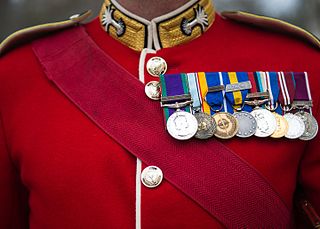
Red coat, also referred to as redcoat or scarlet tunic, is a military garment formerly much used by British infantrymen, so customarily that the term became a common synecdoche for the soldiers themselves.

The uniforms of the British Army currently exist in twelve categories ranging from ceremonial uniforms to combat dress. Uniforms in the British Army are specific to the regiment to which a soldier belongs. Full dress presents the most differentiation between units, and there are fewer regimental distinctions between ceremonial dress, service dress, barrack dress and combat dress, though a level of regimental distinction runs throughout.

The telnyashka is a horizontally striped undershirt worn as uniform by Russian military personnel. It has stripes in white and in a color that varies according to the unit's affiliation. The most common second color is blue, but a number of other colors are also in use. The garment comes in varying thicknesses and may be sleeved or sleeveless.
The uniforms of the United States Army distinguish soldiers from other service members. U.S. Army uniform designs have historically been influenced by British and French military traditions, as well as contemporary U.S. civilian fashion trends. The two primary uniforms of the modern U.S. Army are the Army Combat Uniform, used in operational environments, and the Army Green Service Uniform, worn during everyday professional wear and during formal and ceremonial occasions that do not warrant the wear of the more formal blue service uniform.
The uniforms of the Australian Army have changed significantly over the past century, although the accoutrements worn over this period have remained relatively similar. The forces of the Australian colonies and the early forces of the Commonwealth post-Federation in 1901 closely followed the uniforms of the British Army. Since then it has continued to be influenced by British but also US styles, as well as including some distinctly Australian designs, reflecting local conditions and trends.

The military bands of the United Kingdom are musical units that serve for protocol and ceremonial duties as part of the British Armed Forces. They have been the basis and inspiration for many military bands in the former British Empire and the larger Commonwealth of Nations as well as musical organizations in other countries. Military musical units with British influence include United States military bands, the Japan Ground Self-Defense Force Music Corps and the Military Band of Athens. British military bands are controlled by the military music departments of the three services that compose the armed forces. These include the Royal Marines Band Service, the Royal Corps of Army Music, and the Royal Air Force Music Services. British style brass bands and carnival bands were then and are currently inspired by the British Armed Forces and its brass bands, especially of the Army's regular and reserve formations, as they follow a similar format as it relates to brass and percussion instruments.